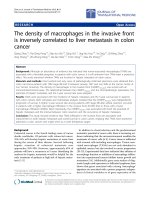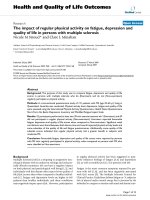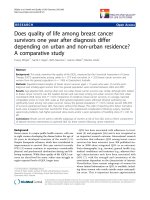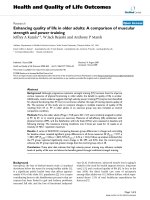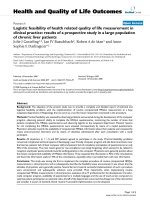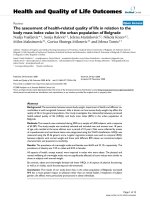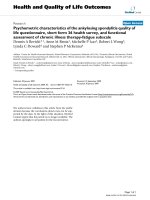báo cáo hóa học:" Health-related quality of life in urban surgical emergency department patients: Comparison with a representative German population sample" docx
Bạn đang xem bản rút gọn của tài liệu. Xem và tải ngay bản đầy đủ của tài liệu tại đây (284.28 KB, 9 trang )
BioMed Central
Page 1 of 9
(page number not for citation purposes)
Health and Quality of Life Outcomes
Open Access
Research
Health-related quality of life in urban surgical emergency
department patients: Comparison with a representative German
population sample
Bruno Neuner*
1
, Peter M Miller
2
, Bodo Felsmann
1
, Edith Weiss-Gerlach
1
,
Tim Neumann
1
, Klaus Dieter Wernecke
3
and Claudia Spies
1
Address:
1
Dept. of Anaesthesiology, Charité-Universitätsmedizin Berlin, Campus Charité-Mitte, Berlin, Germany,
2
Center for Drug and Alcohol
Programs, Medical University of South Carolina, Charleston, SC 29425, USA and
3
Institute of Medical Informatics, Charité-Universitätsmedizin
Berlin, Campus Charité-Mitte, Berlin, Germany
Email: Bruno Neuner* - ; Peter M Miller - ; Bodo Felsmann - ;
Edith Weiss-Gerlach - ; Tim Neumann - ;
Klaus Dieter Wernecke - ; Claudia Spies -
* Corresponding author
Abstract
Background: Patients in emergency departments show a high prevalence of substance use.
Quality of life is associated with substance use as well as socioeconomic status. Little is known
about quality of life in substance-abusing young patients with minor trauma.
Methods: An investigation in an Emergency Department in an inner city university hospital was
conducted during 8 months. Overall, 1,596 patients completed the SF-36 and an established SES-
questionnaire and were screened for substance use (harmful alcohol consumption (≥ 8 points in
men and ≥ 5 points in women on the Alcohol Use Disorders Identification Test (AUDIT), smoking
and illicit drug use). Results were compared with a representative German population sample
(German Federal Health Survey 1998).
Results: Median age of participants was 32 years and 61.8% were male. Mean physical component
summary score (PCS) of the Short Form-36 Health Survey (SF-36) was 53.4 ± 8.3 points and
significantly higher than the age and gender-stratified German Federal Health Survey-data. Mean
mental component summary score (MCS) was 47.9 ± 10.0 points and significantly lower than the
age and gender-stratified German Federal Health Survey-data. In Emergency Department patients,
prevalence of substance use was high and harmful alcohol consumption and illicit drug use were
strongly associated with impaired mental health. Education and occupational status were strongly
positively associated with physical health.
Conclusion: We conclude that there is a high prevalence of substance use in young patients with
minor trauma and mental quality of life is impaired. Screening and brief intervention strategies to
reduce substance-use associated disorders should consider these findings.
Published: 01 December 2005
Health and Quality of Life Outcomes 2005, 3:77 doi:10.1186/1477-7525-3-77
Received: 05 July 2005
Accepted: 01 December 2005
This article is available from: />© 2005 Neuner et al; licensee BioMed Central Ltd.
This is an Open Access article distributed under the terms of the Creative Commons Attribution License ( />),
which permits unrestricted use, distribution, and reproduction in any medium, provided the original work is properly cited.
Health and Quality of Life Outcomes 2005, 3:77 />Page 2 of 9
(page number not for citation purposes)
Background
Recent investigators have shown in different settings that
substance use is associated with impaired Health related
Quality of Life (HRQoL). In alcohol dependent patients,
Daeppen et al. [1] (1998; 147 patients in Switzerland), Mc
Kenna et al. [2] (1996; 586 inpatients in Great Britain)
and Volk et al. [3] (1997; 1333 primary care patients in
USA) found impaired HRQoL in comparison to patients
with lower severity of alcohol dependence, a normal pop-
ulation, and patients without alcohol disorders, respec-
tively. In addition, HRQoL can be improved by
therapeutic intervention in patients with alcohol use dis-
orders. Kraemer et al. [4] (2002; 213 outpatient drinkers
in USA) found, in their 12 months-follow-up study, that
a decrease of 30%+ drinks per month led to a significant
improvement in the mental component summary score of
the SF-36 (p = 0.037), whereas the physical component
summary score of the SF-36 showed a non-significant
trend (p = 0.058).
In patients with illicit drug use, Falck et al. [5] (2000; 443
not-in-treatment crack-cocaine smokers in USA) found a
negative association between drug use and all SF-36
domains except "physical functioning". No association
was found between SF-36 domains and alcohol in these
patients. Reid et al. [6] (2000; less than 50% cannabis
users out of 1581 14–19 years-old in Australia) reported
significantly lower "general health" and "vitality" in the
SF-36 scores of illicit drug users compared to non-users. In
drug users, too, a decrease in substance use led to
improvement in HRQoL: Richter et al. [7] (2004; 100
multiple substance users in Germany) found a significant
improvement in the SF-36 domains of "general health"
and "physical functioning" in 48 patients at follow-up.
In smokers, Wilson et al. [8] (1999; 3010 persons older
than 15 years in a population based survey in South-Aus-
tralia) found, in all (light/moderate/heavy) smokers, sig-
nificantly lower SF-36 domains in comparison to non-
smokers, even after multiple adjustments for age, gender,
socioeconomic status and number of alcoholic drinks per
week. However, these investigators did not adjust for
additional drug use. In a disabled population, Arday et al.
[9] (2003; more than 134,000 elderly and more than
8,600 disabled in the Medical Health Outcomes Survey in
USA) found significantly lower physical (PCS) respec-
tively mental component summary score (MCS) in every-
day and someday smokers compared to non-smokers. In
the elderly, current smokers as well as recent quitters
showed significantly lower PCS and MCS scores than non-
smokers. For the disabled and elderly, MCS scores of long-
term quitters were similar to those of non-smokers.
Substance use not only impairs HRQoL but increases
health care utilization, i.e. emergency department (ED)
visits [10,11]. Furthermore, frequent ED users in various
settings were found to be characterized by improved
HRQoL. Freitag et al. [12] (2005; 785 patients with
chronic daily headache in 2 clinical trials in USA) showed
that ED users were characterized by significantly lower SF-
36 scores than non-ED users. Mandelberg et al. [13]
(2000; database of more than 340,000 ED visits in the San
Francisco General Hospital, USA) found frequent ED
users (equal or more than 5 visits within 12 months) were
more likely than non-frequent users to be homeless, poor,
and diagnosed with alcohol use disorders and/or chronic
illnesses. Although the authors reported no findings on
HRQoL, all of these reported conditions associated with
frequent ED-use are associated with impaired HRQoL.
EDs play an important role in alcohol/drug abuse screen-
ing and brief intervention (SBI) since young patients in
these settings are often at an early stage of their substance
abuse problems. To the best of our knowledge, little is
known about the HRQoL in young patients with minor
trauma in an ED setting. Therefore, the aim of this study
was to evaluate the association of HRQoL, substance use
(smoking, hazardous alcohol consumption and drug con-
sumption) and socioeconomic status in patients with
minor injuries in an inner-city hospital ED.
Methods
After Ethical Committee approval and written informed
consent from all participants, between December 2001
and July 2002, all consecutive patients in the surgical ED
in a university-based hospital in Berlin, Germany, were
included in this investigation. Survey data presented in
this paper were obtained as part of a prospective interven-
tion study to test the effects of a tailored written advice for
hazardous alcohol consumption. Inclusion criteria were
acute trauma and age over 18 years. We excluded patients
who were either unable to give informed consent, admit-
ted by the police, homeless, or those with insufficient
knowledge of the German language. Patients were
screened for substance use ("hazardous alcohol consump-
tion" defined as ≥ 8 points (in men) and ≥ 5 points [14]
(in women) on the Alcohol Use Disorders Identification
Test (AUDIT) [15], "smoking" defined as all current
smokers, and "use of illicit drugs" defined as the use of
illicit drugs a minimum of 1 to 3 or more times within the
last 12 months. Possible categories for illicit drug use were
"Marihuana; Cocaine; Ecstasy; Heroin; and Other".
Socioeconomic parameters [16] were divided into binary
variables including the following: (1) School education:
12 or 13-years-school education ("A-level") vs. a school
education of 11 or less than 11 years ("no A-level"), (2)
Family income: "equal or less than 24,000 Euro net per
year" and "more than 24,000 Euro net per year", (3) Part-
nership: "Yes" and "No", independently of marital status,
Health and Quality of Life Outcomes 2005, 3:77 />Page 3 of 9
(page number not for citation purposes)
(4) Size of household: "one-person-household" and
"household with more than one person", and (5) "Work-
ing" was defined as any legally paid work, either part- or
full-time, including civil servant, self-employed or paid
worker in a family business. "Not working" included all
students, trainees, unemployed people, homemakers, and
according to German law, patients in civil services or mil-
itary service (except professional soldiers). "Not working"
also included, retired patients, and patients engaged in
non-profit voluntary work.
Surgical and trauma data such as trauma diagnosis and
Injury Severity Scores (ISS) were collected after surgical
treatment [17].
HRQoL was measured using the German version of the
Short Form-36 Health Survey (SF-36) [18,19]. Compo-
nent summary scores were calculated using the official
German algorithm, using American weights to allow
international comparison of results [20]. The mental com-
ponent summary score (MCS) includes mental health
(nervousness/depression vs. happiness and calmness),
role emotional (work performance as related to emo-
tional functioning), social functioning (performance of
social activities), and vitality (energy level). The physical
component summary score (PCS) includes physical func-
tioning (performance of physical activities), role physical
(work performance as related to physical functioning),
pain (pain severity), and general health (overall personal
health). The SF-36 questionnaire is a well accepted,
generic instrument, that can be used independently of
health conditions and that is applicable to patients with
only minor medical disorders [19]. The SF-36-question-
naire used in this investigation is considered to be a "val-
idated global quality of life measure" in patients with
(multiple) injuries [21]. In previous investigations, the SF-
36 served as an outcome measure to capture – apart from
medical outcomes – patients' subjective views of their per-
ceived quality of health.
PCS and MCS-data from this investigation were compared
with data from the German Federal Health Survey 1998
[22]: The German Federal Health Survey (BGS98) began
in October 1987 and included approximately 7,200 par-
ticipants. It was financed by the German Ministry of
Health and conducted by the Robert Koch Institute (RKI)
. The RKI is a governmental institution
mainly responsible for the Federal Health Reporting Serv-
ice (Gesundheitsberichterstattung des Bundes, GBE),
regarding surveillance, health status and health behavior
of the population. BGS98 data were obtained using coun-
try-wide sampling based on randomly selected registra-
tion offices, with participants undergoing a medical
check-up and an interview regarding health-relevant
issues [22]. Therefore, the BGS98 is regarded as a valid
representative survey, which has been used extensively as
a standard measure of the heath status of the German
population. However, for this investigation, original Ger-
man Health Survey-1998 data (available in Public Use
files) were compared with data from our study. Out of
7,124 datasets in the German Health Survey- 1998, 228
(4.0%) MCS and PCS datasets were missing; therefore
analysis was based on 6,836 consecutive patients.
Statistical analysis
All binary and categorical variables are shown as frequen-
cies. Metric variables are shown as medians (range) when
not normally distributed and median ± standard devia-
tion when normally distributed. Statistical analysis for dif-
ferences between two independent groups was performed
using a Χ
2
-test for binary variables, and by using the
Mann-Whitney-U-Test for not normally distributed met-
ric variables and t-test for normally distributed metric var-
iables. The correlative structure between MCS respectively
PCS as dependent variables, and covariates (age, gender,
ISS trauma-score, socioeconomic status (high school
degree, family income, partnership, size of household,
employment status), and substance use (harmful alcohol
consumption, smoking and illicit drug use)) was analyzed
using linear multiple regression with stepwise variable
selection procedure. An α-level of 0.05 was used as the
level of significance. To compare PCS and MCS between
emergency department patients and data in the German
Federal Health Survey, a multifactor analysis of variance
(ANOVA) was conducted with "setting", "gender" and
"age-group" as fixed factors. To test for homogeneity of
variances, the Levene's Test for Equality of Variances was
administered, in order to adapt the α-level in case of het-
erogeneity. Statistical analyses were performed using SPSS
(Microsoft SPSS for Windows, version 12.0).
Results
Between December 2001 and July 2002, 1,779 consecu-
tive ED patients were included in the study. Of these, 39
SF-36-questionnaires were incomplete. Of the remaining
1,740 datasets, 144 were incomplete due to missing in the
socioeconomic parameters. Therefore, the final database
consisted of 1,596 patients (89.7% of 1,779).
Of these 1,596 consecutive patients, 61.8% were men and
the overall median age was 32 (18 – 89) years. More than
80% of all patients were characterized by minor trauma
(ISS = 1). The maximum ISS was 10 points, suggesting
that this population was a homogenous group with minor
trauma. In regard to specific ICD-10 diagnosis, 14.1%,
respectively 4.2% of all patients had trauma diagnoses
belonging to the S0-and S1-Group (Head respectively
neck injuries, mainly head lacerations), another 4.1%
respectively 1.3% showed diagnosis of the S2, respectively
S3-group, which meant injuries of the thorax, respectively
Health and Quality of Life Outcomes 2005, 3:77 />Page 4 of 9
(page number not for citation purposes)
abdomen, overall 73.5% of diagnoses belonged to the S4
– S9 group, with 35.4% diagnoses of the upper extremities
and the shoulder and 38.1% injuries of the lower extrem-
ities and the hip. Most of these injuries were bruises and
lacerations, fractures of finger, hand or forearm ore ankle
torsions. A total of 43 patients (2.7%) showed multiple
injuries. Detailed socioeconomic and substance abuse
parameters are presented in Table 1. Men in comparison
to women were less likely to have an A-level and were
more often employed and living alone. The prevalence of
hazardous alcohol consumption, smoking and illicit drug
use was significantly higher in men than in women. Con-
cerning HRQoL, overall physical component summary
score (PCS) was 53.4 ± 8.3 points with higher PCS in men
(53.9 ± 7.5 points) than in women (52.5 ± 9.3 points), p
= 0.003). The mental component summary score (MCS)
was 47.9 ± 10.0 points with higher MCS in men (48.5 ±
9.4 points) than in women (46.9 ± 10.8 points), p =
0.003).
When entering the anthropometric, injury, socioeco-
nomic and substance use parameters presented in table 1
into 2 regression models with the physical component
summary score (Table 2) and the mental component
summary score (Table 3) as dependent variables, we
found that male gender, A-level, and being employed
were positively associated with a significant increase in
physical HRQoL. However, with every life year there was
a small but significant decrease in physical HRQoL (+
every additional life year: -0.2 ± 0.02 points in PCS, p <
0.001). Concerning mental health, with every life year
there was a small but significant increase in mental
HRQoL (+ every additional life year: +0.05 ± 0.02 points
in MCS, p = 0.012). Other factors positively associated
Table 1: Basic characteristics, socio-economic status, substance use and Health Related Quality of Life in all patients
Variable all n = 1596 male n = 986 61.8% female n = 610 38.2 % p
Age (1) (years) 32 (18 – 89) 32 (18 – 78) 31 (18 – 89) 0.306
ISS (%) >1/1 point 18.3/81.7 19.7/80.3 16.1/83.9 0.070
Socioeconomic status
A-Level (%) no/yes 43.9/56.1 46.2/53.8 40.2/59.8 0.017
Being employed(%) no/yes 36.4/63.6 33.7/66.3 40.8/59.2 0.004
Family income (%)*
≤24,000 €/>24,000 €
62.2/37.8 62.1/37.9 62.5/37.5 0.876
Partnership (%) no/yes 54.3/45.7 54.7/45.3 53.6/46.4 0.680
Size of household (%) 1/>1
person
36.8/63.2 39.7/60.3 32.3/67.7 0.003
Substance use
Hazardous alcohol
consumption # (%) yes/no
24.7/75.3 26.5/73.5 22.0/78.0 0.043
Illicit drug use (%) yes/no 21.7/78.3 25.6/74.4 15.6/84.4 < 0.001
Smoking (%) yes/no 45.7/54.3 51.7/48.3 36.1/63.9 < 0.001
Health Related Quality of Life (HRQoL)
PCS (2) 53.4 ± 8.3 53.9 ± 7.5 52.5 ± 9.3 0.003
MCS (2) 47.9 ± 10.0 48.5 ± 9.4 46.9 ± 10.8 0.003
(1): median (range); (2): mean ± standard deviation; ISS: Injury Severity Score; A-level: "yes": 12 or 13 years of school education, "no": 11 or less
years of school education; *; family income net per year; #: hazardous alcohol consumption "yes": (in men): AUDIT = 8 – 40 points, (in women):
AUDIT = 5 – 40 points, "no": (in men): AUDIT = 0 – 7 points, (in women): AUDIT = 0 – 4 points; PCS: physical component summary score of the
SF-36; MCS: mental component summary score of the Sf-36.
Table 2: Results of the linear multiple regression model (with stepwise variable selection procedure), dependent variable = physical
component summary score of the SF-36 (PCS)
Covariates β
x
-coefficient se (β
x
)p
β
0
57.03 1.02 < 0.001
Age (+ 1 year) (β
1
) -0.20 0.02 < 0.001
Male gender (β
2
) 0.97 0.40 0.015
A-level (β
3
) 2.88 0.39 < 0.001
Being employed (β
4
) 2.73 0.40 < 0.001
Household > 1 person (β
7
) -0.72 0.39 0.071
Model = β
0
+ β
1
* age + β
2
* male gender + β
3
* A-level + β
4
* being employed + β
5
* income > 24,000€/year + β
6
*partnership + β
7
* household >
1 person + β
8
* hazardous alcohol consumption + β
9
* illicit drug use + β
10
* smoking + β
11
* ISS > 1 point.
A-Level: 12 or 13 years of school education, ISS = Injury Severity Score.
Health and Quality of Life Outcomes 2005, 3:77 />Page 5 of 9
(page number not for citation purposes)
with mental health were male gender, a yearly income
above 24,000€, and living in a more-person-household.
In this investigation, injuries with more than 1 ISS-point
were associated with a higher MCS. All substance use
parameters (with illicit drug use showing the strongest
association (-2.74 ± 0.64 points, p < 0.001)) were nega-
tively associated with mental health, although smoking
showed a non-significant trend (-0.87 ± 0.52 points, p =
0.097).
The physical HRQoL in ED patients in comparison to a
representative sample in Germany (n = 6,836) is shown in
Figure 1. ED patients, in all age groups except 18–19-year-
olds, showed a better physical HRQoL than the represent-
ative German population sample. Taking both samples
together, age explained the most variance in the overall
data, followed by "setting". Gender differences explained
less variance in the model.
The mental HRQoL in ED patients in comparison to a rep-
resentative sample in Germany (n = 6836) is shown in
Figure 2. MCS scores in ED patients in all but one age-
group (50 – 59 years) were found to be lower compared
to the representative German sample. Concerning mental
health, "setting" was the variable explaining the most var-
iance when considering both populations together. Gen-
der differences explained the second highest proportion
of variance, followed by age.
Discussion
The most important result of this study was the lowered
mental quality of life in young ED patients with minor
trauma in comparison to a representative German popu-
lation sample. Physical quality of life in ED patients was
even better than in the representative German population
sample. In ED patients the absence of substance use
parameters such as illicit drug use and harmful alcohol
consumption as well as male gender, older age and a high
family income were positively associated with mental
health. Better physical health in ED patients was posi-
tively associated - apart from male gender and younger
age – with protective socioeconomic parameters such as
A-level and being employed.
Mental HRQoL in young ED patients with minor trauma
was strongly negatively associated with substance use
parameters, especially alcohol and illicit drug use. These
results reflect previous findings in different settings [1-7].
Smoking alone showed only a negative tendency. Our
findings suggest as well that family income and size of
household were the independent relevant factors associ-
ated with mental HRQoL. A higher income may provide
more opportunities to meet personal demands and may
lead to higher satisfaction and thus improved mental
HRQoL. Male ED patients showed better mental HRQoL
than female ED patients; better mental HRQoL in men in
comparison to women was reported in BGS-98-data in
Germany [23] as well as in data from the Whitehall II
Study [24].
Concerning physical health, in this predominant young
population (median age = 32 years), substance use
parameters were not associated with physical health. One
explanation might be that these patients were too young
to be, for example, seriously affected by alcohol-related
disorders which appear in later years. In an other investi-
gation we found a median age of 42 years in severely
injured alcohol dependent patients [25], a median age of
47 years was reported in 167 patients with alcohol associ-
ated liver cirrhosis [26] and a median age of patients with
alcohol associated tumors of the upper digestive tract who
underwent tumor resection was found to be 56 years [27].
Table 3: Results of the linear multiple regression model (with stepwise variable selection procedure), dependent variable = mental
component summary score of the SF-36 (MCS)
Covariates β
x
-coefficient se (β
x
)p
β
0
39.28 2.02 < 0.001
Age (+ 1 year) (β
1
) 0.05 0.02 0.012
Male gender (β
2
) 2.22 0.51 < 0.001
Income > 24,000 €/year (β
3
) 1.52 0.53 0.004
Household > 1 person (β
7
) 1.31 0.51 0.010
Hazardous alcohol consumption
(β
8
)
-1.84 0.59 0.002
Illicit drug use (β
9
) -2.74 0.64 < 0.001
Smoking (β
10
) -0.87 0.52 0.097
ISS > 1 point (β
11
) 1.251 0.63 0.048
Model = β
0
+ β
1
* age + β
2
* male gender + β
3
* A-level + β
4
* being employed + β
5
* income > 24,000€/year + β
6
*partnership + β
7
* household >
1 person + β
8
* hazardous alcohol consumption + β
9
* illicit drug use + β
10
* smoking + β
11
* ISS > 1 point.
A-Level: 12 or 13 years of school education, ISS = Injury Severity Score
Health and Quality of Life Outcomes 2005, 3:77 />Page 6 of 9
(page number not for citation purposes)
Physical Component Summary Score (PCS) in different age-groups in Emergency Department patients and in participants in the German Federal health survey 1998Figure 1
Physical Component Summary Score (PCS) in different age-groups in Emergency Department patients and in participants in the
German Federal health survey 1998.
18-19 20-29 30-39 40-49 50-59 >= 60
Age in years
42,50
45,00
47,50
50,00
52,50
55,00
Mean PCS-Score of the SF-36 in points
Emergency
Department
n = 1,596
German
Federal Health
Survey 1998
n = 6,836
Physical Component Score (PCS) of the SF-36
Results of multifactor analysis of variance (ANOVA); Levene-Test: p < 0.001.
Parameter F-value p
Gender 19.54 < 0.001
Age-group 96.66 < 0.001
Setting 40.85 < 0.001
Gender * age-group 1.91 0.090
Gender * setting 0.78 0.378
Age-group * setting 1.66 0.140
Gender * age-group * setting 1.06 0.384
Health and Quality of Life Outcomes 2005, 3:77 />Page 7 of 9
(page number not for citation purposes)
Mental Component Summary Score (MCS) in different age-groups in Emergency Department patients and in participants in the German Federal health survey 1998Figure 2
Mental Component Summary Score (MCS) in different age-groups in Emergency Department patients and in participants in the
German Federal health survey 1998.
18-19 20-29 30-39 40-49 50-59 >= 60
Age in years
44,00
46,00
48,00
50,00
52,00
54,00
Mean MCS-Score of the SF-36 in points
Emergency
Department
n= 1,596
German
Federal Health
Survey 1998
n = 6,836
Mental Component Summary Score (MCS) of the SF-36
Results of multifactor analysis of variance (ANOVA); Levene-Test: p < 0.001.
Parameter F-value p
Gender 41.16 < 0.001
Age-group 16.38 < 0.001
Setting 49.67 < 0.001
Gender * age-group 1.11 0.354
Gender * setting 0.33 0.567
Age-group * setting 3.98 0.001
Gender * age-group * setting 1.50 0.187
Health and Quality of Life Outcomes 2005, 3:77 />Page 8 of 9
(page number not for citation purposes)
Therefore in these young trauma patients, substance use
parameters may not (yet) be important factors in affecting
physical HRQoL.
However, socioeconomic data were associated with phys-
ical HRQoL – apart from gender and age, which are both
established predictors of physical HRQoL (gender: in
both, BGS98 [23] and Whitehall II study [24], with
increasing age an impaired physical HRQoL was found. In
the USA, Arday et al. [9] (2003, more than 130,000 elderly
respectively more than 8,600 impaired) found a decrease
in physical HRQoL of 0.45 points respectively 0.29 points
for every additional life year. Not surprisingly, in our
investigation, a decrease of 0.2 ± 0.02 points in physical
HRQoL was found with every additional life year. In ED
patients, a higher educational level and being employed
was associated with improved physical HRQoL. Heming-
way et al. [24] (1997, more than 10,000 participants in
the Whitehall II study in GB) found that lower employ-
ment grade was positively associated with lower physical
HRQoL. In both gender, all SF-36 domains in the BGS98-
data [23] (Kurth & Ellert 2002, German representative
population sample of 7,200 participants) – even after
multiple adjustments for age, region and community size
– were positively associated with social class. In our inves-
tigation in young trauma patients, no association was
found between physical HRQol and income. Woolf et al.
[28] (1998, 555 patients in an inner-city family practice
center in USA) found in patients with a yearly income of
less than $15,000 lower physical function scores then
those repeated nationally for patients with hypertension,
diabetes, depression or recent myocardial infarction.
However, these patients were older then the trauma pop-
ulation in this investigation.
The lower mental HRQoL in younger ED patients in com-
parison with the representative BGS-data may be partly
due to the high prevalence of substance use parameters in
ED patients. Data are not easily comparable since the
AUDIT-questionnaire was not used in the BGS-Survey and
illicit drug use was evaluated using a different algorithm.
However, evidence from other representative population
surveys in Germany suggest lower population-based prev-
alence rates (alcohol: dependence 3%; misuse 5% and
overall at risk consumption 16% in 2000; smoking: 27%
smoking prevalence 2003 in the population equal or
older than 15 years; illicit drug use: 12-month-prevalence:
6.5% of the population in West-Germany and 5.2% in
East-Germany in 2000) [29].
To the best of our knowledge, no comparable data are
available concerning our findings on better physical
HRQoL. There are several investigations on trauma
patients in urban settings. Sims et al. [10] (1989, 501 sur-
vivors of violent trauma in USA) used the terminus
"urban trauma" to characterize young, male patients with
high prevalence of substance use and unemployment,
who showed 44% trauma recidivism and a 5-years-mor-
talityof 20% at follow-up. Other investigators in urban
(Smith RS et al. [30], 1992: 342 trauma recidivists in an
urban trauma center, USA; Reiner DS et al. [31], 1990: 150
consecutive admissions in a level 1-Trauma-Center, USA)
as well in rural settings (Poole GV et al. [11], 1993: 200
trauma patients in a university hospital and level I trauma
center, USA; Sayfan and Berlin [32], 1997: 100 trauma
cases in northern Israel) reported young age, male gender,
previous admission for trauma and positive alcohol blood
level during admission as being risk factors for recurrent
trauma.
None of these investigations reported data on HRQoL.
However, even this population with minor trauma was
characterized by parameters (male gender, young age,
high prevalence of substance use) which were found to be
associated with more severe trauma and even trauma
recidivism. Assuming that in our investigation we received
information on patients at a very early stage of a worsen-
ing career of substance use and repetitive injuries, we con-
sider the younger of these patients being "sensation
seekers" [33] with as yet unaffected physical health but
impaired mental health. At this early stage, patients may
consider themselves "invincible" and their substance use
as well as their injuries may be the result of unaffected
physical health in combination with impaired mental
health and impaired coping strategies. We found sub-
stance use, especially alcohol consumption, in these ED
patients associated with poor coping capability [34].
Thus, minor injuries in our study population would not
be the result of random effects, but triggered by an
impaired mental HRQoL as well as impaired coping abil-
ity in combination with unaffected physical health that
may lead to risky behaviors such as substance use.
Conclusion
In comparison to the general population young patients
treated for minor trauma in an urban ED showed an
impaired mental health related quality of life in combina-
tion with an improved physical health related quality of
life. Together with a high prevalence of substance use, this
cluster may play a causal role in unintentional injuries.
Screening and brief intervention programs on substance
use in Emergency Departments should consider this find-
ing and appropriate health promoting strategies focusing
on improvement of mental health should be integrated in
SBI.
Authors' contributions
Neuner B contributed in the design of the study, coordi-
nated data collection, training of the study staff, made the
data analysis and wrote the article, Miller P helped to
Health and Quality of Life Outcomes 2005, 3:77 />Page 9 of 9
(page number not for citation purposes)
design the study and revised the article critically for
important intellectual content, Bodo Felsmann made sub-
stantial contributions to data collection and revised the
article critically, Edith Weiss-Gerlach and Tim Neumann
contributed in the design of the study, coordinated data
collection, training of the study staff and revised the article
critically, Klaus Dieter Wernecke contributed substantially
in statistical analysis and interpretation and Claudia Spies
designed and coordinated the study, revised the article
critically and gave final approval of the version to be pub-
lished.
Acknowledgements
Financial Support: This study was sponsored by the German Ministry of
Health (BMG 217-43794-5/5).
References
1. Daeppen JB, Krieg MA, Burnand B, Yersin B: MOS-SF-36 in evalu-
ating health-related quality of life in alcohol-dependent
patients. Am J Drug Alcohol Abuse 1998, 24:685-694.
2. McKenna M, Chick J, Buxton M, Howlett H, Patience D, Ritson B:
The SECCAT survey: I. The costs and consequences of alco-
holism. Alcohol Alcohol 1996, 31:565-576.
3. Volk RJ, Cantor SB, Steinbauer JR, Cass AR: Alcohol use disorders,
consumption patterns, and health-related quality of life of
primary care patients. Alcohol Clin Exp Res 1997, 21:899-905.
4. Kraemer KL, Maisto SA, Conigliaro J, McNeil M, Gordon AJ, Kelley
ME: Decreased alcohol consumption in outpatient drinkers is
associated with improved quality of life and fewer alcohol-
related consequences. J Gen Intern Med 2002, 17:382-386.
5. Falck RS, Wang J, Carlson RG, Siegal HA: Crack-cocaine use and
health status as defined by the SF-36. Addict Behav 2000,
25:579-584.
6. Reid A, Lynskey M, Copeland J: Cannabis use among Australian
adolescents: findings of the 1998 National Drug Strategy
Household Survey. Aust N Z J Public Health 2000, 24:596-602.
7. Richter D, Eikelmann B, Berger K: Use of the SF-36 in the evalu-
ation of a drug detoxification program. Qual Life Res 2004,
13:907-914.
8. Wilson D, Parsons J, Wakefield M: The health-related quality-of-
life of never smokers, ex-smokers, and light, moderate, and
heavy smokers. Prev Med 1999, 29:139-144.
9. Arday DR, Milton MH, Husten CG, Haffer SC, Wheeless SC, Jones
SM, Johnson RE: Smoking and functional status among Medi-
care managed care enrollees. Am J Prev Med 2003, 24:234-241.
10. Sims DW, Bivins BA, Obeid FN, Horst HM, Sorensen VJ, Fath JJ:
Urban trauma: a chronic recurrent disease. J Trauma 1989,
29:940-946.
11. Poole GV, Griswold JA, Thaggard VK, Rhodes RS: Trauma is a
recurrent disease. Surgery 1993, 113:608-611.
12. Freitag FG, Kozma CM, Slaton T, Osterhaus JT, Barron R: Charac-
terization and prediction of emergency department use in
chronic daily headache patients. Headache 2005, 45:891-898.
13. Mandelberg JH, Kuhn RE, Kohn MA: Epidemiologic analysis of an
urban, public emergency department's frequent users. Acad
Emerg Med 2000, 7:637-646.
14. Neumann T, Neuner B, Gentilello LM, Weiss-Gerlach E, Mentz H,
Rettig JS, Schroder T, Wauer H, Muller C, Schutz M, Mann K, Siebert
G, Dettling M, Muller JM, Kox WJ, Spies CD: Gender differences
in the performance of a computerized version of the alcohol
use disorders identification test in subcritically injured
patients who are admitted to the emergency department.
Alcohol Clin Exp Res 2004, 28:1693-1701.
15. Saunders JB, Aasland OG, Babor TF, de la Fuente JR, Grant M: Devel-
opment of the Alcohol Use Disorders Identification Test
(AUDIT): WHO Collaborative Project on Early Detection of
Persons with Harmful Alcohol Consumption II. Addiction
1993, 88:791-804.
16. 2000 Allbus Standardkategorien. Zentrum für Umfragen und
Methoden und Analysen (ZUMA) Mannheim, Germany 2003.
17. Baker SP, O'Neill B, Haddon WJ, Long WB: The injury severity
score: a method for describing patients with multiple injuries
and evaluating emergency care. J Trauma 1974, 14:187-196.
18. Bullinger M: German translation and psychometric testing of
the SF-36 Health Survey: preliminary results from the
IQOLA Project. International Quality of Life Assessment.
Soc Sci Med 1995, 41:1359-1366.
19. Bullinger M: Erfassung der gesundheitsbezogenen Lebensqual-
ität mit dem SF-36 Health Survey. [Assessment of health
related quality of life with the SF-36 Health Survey]. Rehabil-
itation (Stuttg) 1996, 35:XVII-XXVII.
20. Ellert U, Kurth BM: Methodische Betrachtungen zu den Sum-
menscores des SF-36 anhand der erwachsenen bundesdeut-
schen Bevölkerung. [Methodological views on the SF-36
summary scores based on the adult German population.].
Bundesgesundheitsblatt Gesundheitsforschung Gesundheitsschutz 2004,
47:1027-1032.
21. Bouillon B, Kreder HJ, Eypasch E, Holbrook TL, Kreder HJ, Mayou R,
Nast-Kolb D, Pirente N, Schelling G, Tiling T, Yates D: Quality of
life in patients with multiple injuries basic issues, assess-
ment, and recommendations. Restor Neurol Neurosci 2002,
20:125-134.
22. Bellach BM, Knopf H, Thefeld W: Der Bundes-Gesundheitssur-
vey 1997/98. [The German Health Survey. 1997/98]. Gesund-
heitswesen 1998, 60 Suppl 2:S59-S68.
23. Kurth BM, Ellert U: The SF-36 questionnaire and its usefulness
in population studies: results of the German Health Inter-
view and Examination Survey 1998. Soz Praventivmed 2002,
47:266-277.
24. Hemingway H, Nicholson A, Stafford M, Roberts R, Marmot M: The
impact of socioeconomic status on health functioning as
assessed by the SF-36 questionnaire: the Whitehall II Study.
Am J Public Health 1997, 87:1484-1490.
25. Spies CD, Neuner B, Neumann T, Blum S, Muller C, Rommelspacher
H, Rieger A, Sanft C, Specht M, Hannemann L, Striebel HW, Schaf-
fartzik W: Intercurrent complications in chronic alcoholic
men admitted to the intensive care unit following trauma.
Intensive Care Med 1996, 22:286-293 [http://PM:8708164
].
26. Platz KP, Mueller AR, Spree E, Schumacher G, Nussler NC, Rayes N,
Glanemann M, Bechstein WO, Neuhaus P: Liver transplantation
for alcoholic cirrhosis. Transpl Int 2000, 13 Suppl 1:S127-S130.
27. Spies CD, Nordmann A, Brummer G, Marks C, Conrad C, Berger G,
Runkel N, Neumann T, Muller C, Rommelspacher H, Specht M, Han-
nemann L, Striebel HW, Schaffartzik W: Intensive care unit stay is
prolonged in chronic alcoholic men following tumor resec-
tion of the upper digestive tract. Acta Anaesthesiol Scand 1996,
40:649-656.
28. Woolf SH, Rothemich SF, Johnson RE, Marsland DW: The func-
tional status of inner-city primary care patients. Diminished
function in a family practice population and its potential
determinants. J Fam Pract 1998, 47:312-315.
29. Deutsche Hauptstelle für Suchtfragen e.V.Geesthacht G: . Jahrbuch
Sucht 2005.
30. Smith RS, Fry WR, Morabito DJ, Organ CHJ: Recidivism in an
urban trauma center. Arch Surg 1992, 127:668-670.
31. Reiner DS, Pastena JA, Swan KG, Lindenthal JJ, Tischler CD: Trauma
recidivism. Am Surg 1990, 56:556-560.
32. Sayfan J, Berlin Y: Previous trauma as a risk factor for recurrent
trauma in rural northern Israel. J Trauma 1997, 43:123-125.
33. Field CA, O'Keefe G: Behavioral and psychological risk factors
for traumatic injury. J Emerg Med 2004, 26:27-35.
34. Neuner B, Miller P, Maulhardt A, E. WG, Neumann T, Lau A, Brahler
E, Helmert U, Haas N, Muller JM, Wernecke KD, Spies C: Hazard-
ous alcohol consumption and sense of coherence in emer-
gency department patients with minor trauma. Drug Alcohol
Depend 2005-E-publication ahead of print.
